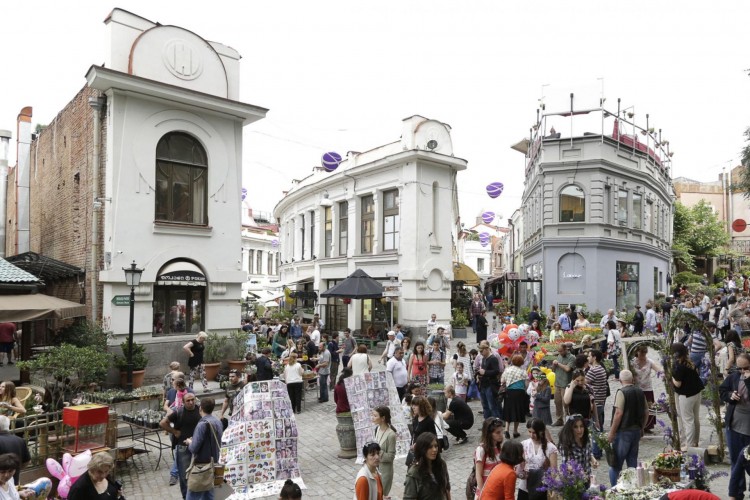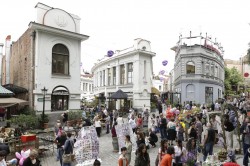Meeting point on the map
Tbilisi to Mtskheta tour offers you a fascinating promenade in two capital cities of Georgia – Tbilisi and Mtskheta. Within one day you will visit two cities that are in 20 km distance from each other and see the whole variety and beauty of them. Tbilisi is the largest city of the country and was founded in V c A.D. It is located along Mtkvari river mouth. It is diverse with the culture, styles, and traditions. And Mtskheta is a small city, a spiritual center of the country, “Second Jerusalem” and the place where two rivers – Aragvi and Mtkvari – merge. You will see the ancient historical monuments, have a stroll on the brick streets, and will have the opportunity to watch the lifestyle of the local citizens.
Meeting point address: Bicycle Monument, Rose Revolution Square, Tbilisi Meeting time:10:00 am
The meeting point on the map is in detail see in the additional information section.
In the morning you will have a stroll in Tbilisi city.
During it you will visit:
Tbilisi city offers a wide variety of sights, most of them very ancient. Starting at the church of Metekhi, we walk to the brick domes of sulfur baths and then on to spectacularly located Narikala’s fortress – one of the oldest fortresses in Georgia, overlooking the Mtkvari river gorge. Metekhi Church is located in the ancient historical district of Metekhi, on the left bank of the Mtkvari River, in old Tbilisi. Metekhi Church of the Nativity of the Virgin Mary is one of the oldest churches built in Tbilisi. Researchers confirm that the temple was built in the 6th century. King Vakhtang I Gorgasali erected a church, a castle, and a palace here, which also served as the king's residence Sulfur baths - Chreli Abano located at the eastern bank of the Mtkvari River at the foot of Narikala fort across Metekhisubani, Abanotubani is an important historic part of the city — the place, where according to a legend the King of Iberia, Vakhtang Gorgasali’s falcon fell, leading to a discovery of the hot springs and, subsequently, to the founding of new capital.
Narikala’s fortress - is nowadays the leading sighting among the most visited places in Tbilisi by tourists. Narikala Fortress draws your attention from all sides of Tbilisi, you can notice it from almost every part of Tbilisi. It overlooks the Mtkvari River, which makes Narikala even more incredible. Narikala consists of two walled sections between the sulfur baths and the Tbilisi Botanical Garden. The fortress walls date from various periods, the earliest from the 4th century when it was a Persian citadel. Most of the present walls were built in the 8th century by the Arab emirs, whose palace was inside the fortress. In Georgian sources, it is called “Mother Fortress”. Narikala offers you some of the best panoramas of the city. This is an ancient symbol of Tbilisi’s defensive brilliance. You will get there by cable car.
Walk on Meidan Square which was an active marketplace in the Great Silk Road period. Jean Chardin Street -the street was named after the famous French traveler and now it is the most popular place for the citizens and tourists where they can rest in bars and restaurants.
After the Capital of Georgia, we will visit the old capital city Mtskheta Archeological evidence trace human settlement in the area of Mtskheta from the 2nd millennium BC to the early 1st millennium AD. Numerous burials of the Bronze Age (beginning of the 1st millennium BC) prove that Mtskheta already was a significant settlement at that period. Mtskheta was the capital of the early Georgian Kingdom of Iberia from the 3rd century BC to the 5th century AD. Svetitskhoveli Cathedral - the main patriarchal cathedral of the Georgian Orthodox Church, the Mother Cathedral of Georgia, the place of enthronement (enthronement) of the Georgian Catholicos-Patriarchs, the burial of many kings of Georgia, their family members and patriarchs from the great cathedrals. Monument of Georgian architecture of the XI century, one of the four great cathedrals (Oshki, Bagrati Temple, Alaverdi). Svetitskhoveli is the largest historical church building among the surviving ones in Georgia. It has been the religious center of Christian Georgia for centuries.
Jvari Monastery- VI century church and monastery, located in the east of Mtskheta, at the mouth of the river Mtkvari and Aragvi, on the rocky mountain peak. Jvari Monastery is included in the UNESCO World Heritage List. Here there is kept the Robe of Jesus Christ which had been brought from Jerusalem in I c. A true architectural masterpiece of the Early Middle Ages. Built on a hilltop, the views it affords of Mtskheta and the Aragvi and Mtkvari Rivers are breathtaking and great for selfies!
After we will continue our way and see Samtavro Monastery which is located in the city of Mtskheta. It is one of the most important cultural monuments. St. Nino lived here, and King Mirian and Queen Nana are buried here. Abibo Nekreseli, one of the Assyrian fathers, is also buried in the Samtavro monastery. The complex includes several buildings: the main temple, St. Nino's church, a bell tower, and a fence with a tower. The main temple dates back to the 11th century With this, our interesting, cultural and historical tour is over We will return to Tbilisi in the afternoon for drop-off at your hotel















/public/623/e1f/63c/623e1f63c3126942164822.jpg 1x, https://sakurageorgia.com/storage/app/uploads/_thumbs/cover(800,448)/public/623/e1f/63c/623e1f63c3126942164822.jpg 2x)
/public/623/e1f/732/623e1f7325eac488169501.jpg 1x, https://sakurageorgia.com/storage/app/uploads/_thumbs/cover(800,448)/public/623/e1f/732/623e1f7325eac488169501.jpg 2x)
/public/624/4b6/dd3/6244b6dd312a2122503603.jpg 1x, https://sakurageorgia.com/storage/app/uploads/_thumbs/cover(800,448)/public/624/4b6/dd3/6244b6dd312a2122503603.jpg 2x)
/public/624/b4e/68d/624b4e68d1d73349605045.jpg 1x, https://sakurageorgia.com/storage/app/uploads/_thumbs/cover(800,448)/public/624/b4e/68d/624b4e68d1d73349605045.jpg 2x)
/public/63f/22c/218/63f22c218dff0611544278.jpg 1x, https://sakurageorgia.com/storage/app/uploads/_thumbs/cover(800,448)/public/63f/22c/218/63f22c218dff0611544278.jpg 2x)
/public/63f/36f/e17/63f36fe1772b9229049404.jpg 1x, https://sakurageorgia.com/storage/app/uploads/_thumbs/cover(800,448)/public/63f/36f/e17/63f36fe1772b9229049404.jpg 2x)
